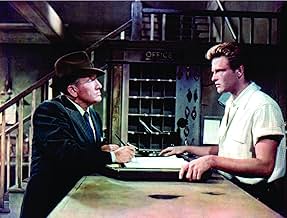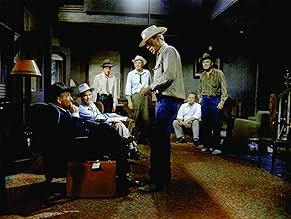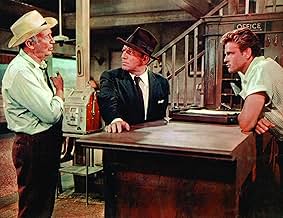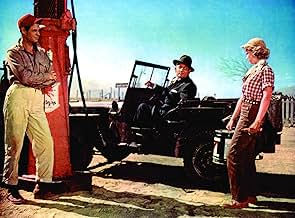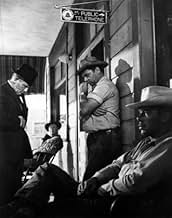Un inconnu manchot arrive dans une petite ville. Il veut garder son terrible passé secret, par des moyens violents si nécessaire.Un inconnu manchot arrive dans une petite ville. Il veut garder son terrible passé secret, par des moyens violents si nécessaire.Un inconnu manchot arrive dans une petite ville. Il veut garder son terrible passé secret, par des moyens violents si nécessaire.
- Réalisation
- Scénario
- Casting principal
- Nommé pour 3 Oscars
- 4 victoires et 8 nominations au total
- Cafe Lounger
- (non confirmé)
- Cafe Lounger
- (non confirmé)
- Cafe Lounger
- (non confirmé)
- Cafe Lounger
- (non confirmé)
- Second Train Conductor
- (non crédité)
- First Train Conductor
- (non crédité)
- One of Two Porters
- (non crédité)
- Tall - White-haired Cafe Lounger
- (non crédité)
Avis à la une
The other reviewers here give a plot outline and performance details. Tracy dominates the picture, his black and white appearance setting out the clarity of his moral position. The other main presence in this classic picture is the silence. Sturges SHOWS us silence, and what denial can do to a community.
I'd just like to make a recommendation to those who think that great cinema need sound and action - watch Bad Day at Black Rock, and sink yourself into its opening emptiness and cut-to-the-bone story.
9/10
Unity of place:everything takes place in a one-horse town,Black Rock,where an unusually inventive use of the wide screen makes the small town even more isolated,cut off from the world.When you leave Black Rock,you find a desolate landscape where only some flowers (of death?as Tracy points out)grow.
Unity of action:something happened in "Black Rock" ,something that its inhabitants are anxious that it remains in the shadow.Enter Tracy who seems to know too many things he should.Then all the inhabitants all stand together ,and their conspiracy of silence becomes threatening.What's amazing is that John Sturges (it's probably his best film,he uses Tracy in a much better way than he did in "people against o'Hara" some years before)refuses the easy way out:take for instance the only female character played by Anne Francis ;she does not act as the audience expects .Stand-out remains Robert Ryan,always excellent in one of his villains parts:funny how an actor who was known for his liberal views should have played so many racists ,anti-Semitics (this film,but also Dmytryk's "crossfire" and Wise's "against all odds").Other good performances come from Marvin and Borgnine.
Unity of time:everything happens in the space of 24 hours;first sequence :the train arrives in Black Rock,last sequence:it leaves it.
This is a modern western,which takes place just after WW2."Bad Day at Black Rock" is also,in its own special way, a war movie ,and also an anti-war one,because Tracy's life was saved by a...
Thoroughly enjoyable ,it deserves its reputation of classic.
John Sturges has done a wonderful job of bringing all of these elements together. One of the things that I found interesting was that there were very few, if any, close-ups. Most of the shots could have been master shots. For me, this made me feel as though I were a by-stander in the room with the characters while they talked. A nice touch.
As expected all of the performances are great. Tracy, Ryan, Brennan, and Jagger are all terrific. As are Lee Marvin and Ernest Borgnine (two actors at the time who were about to break out, and become top-line stars).
If you like classic westerns, and great acting, "Bad Day at Black Rock" will not disappoint.
8 out of 10
Le saviez-vous
- AnecdotesJohn Sturges had already moved on to his next film, Duel d'espions (1955), so Herman Hoffman took charge of filming the opening. The plan was to shoot the train hurtling toward the audience, almost like a 3-D movie, but it would have been deadly to attempt a helicopter maneuver into the path of a speeding locomotive. Stunt flier Paul Mantz offered the perfect solution: have the train running backwards, fly the copter over the retreating engine, then project the footage in reverse. "It's a helluva shot," Sturges later said, "but I didn't make it."
- GaffesAs the train approaches the town, the horn blows twice, which is the signal for starting up. The mandatory signal for a grade crossing (long, long, short, long) is never blown, although one clearly exists. When the train departs, the conductor makes a confused hand signal to the engineer resembling the horizontal motion that means "stop" rather than the vertical motion that means "go". The engineer never responds with the "long, long" starting signal.
- Citations
Reno Smith: I swear, you're beginning to make me mad.
John J. Macreedy: All strangers do, hmm?
Reno Smith: No, they don't. Not all of them. Some do, when they come around snooping...
John J. Macreedy: Snooping for what?
Reno Smith: I don't know, outsiders coming in, looking for something...
John J. Macreedy: Looking for what?
Reno Smith: I don't know! Somebody's always looking for something in this part of the West. To the historian it's the Old West, to the book writer it's the Wild West, to the businessman it's the Undeveloped West -- they say we're all poor and backward, and I guess we are, we don't even have enough water. But to us, this place is *our* West, and I wish they'd leave us alone!
John J. Macreedy: Leave you alone to do what?
Reno Smith: I don't know what you mean.
- Versions alternativesTo receive an 'A' (PG) certificate in 1955 the UK cinema version was subject to heavy BBFC cuts. These included Macreedy striking Hector with the brass fire hose nozzle and the climactic shots of Reno on fire. Later TV showings and video releases were fully uncut.
- ConnexionsFeatured in The Spencer Tracy Legacy: A Tribute by Katharine Hepburn (1986)
Meilleurs choix
Détails
Box-office
- Budget
- 1 271 000 $US (estimé)
- Montant brut mondial
- 10 813 $US
- Durée1 heure 21 minutes
- Couleur
- Rapport de forme
- 2.35 : 1
Contribuer à cette page



